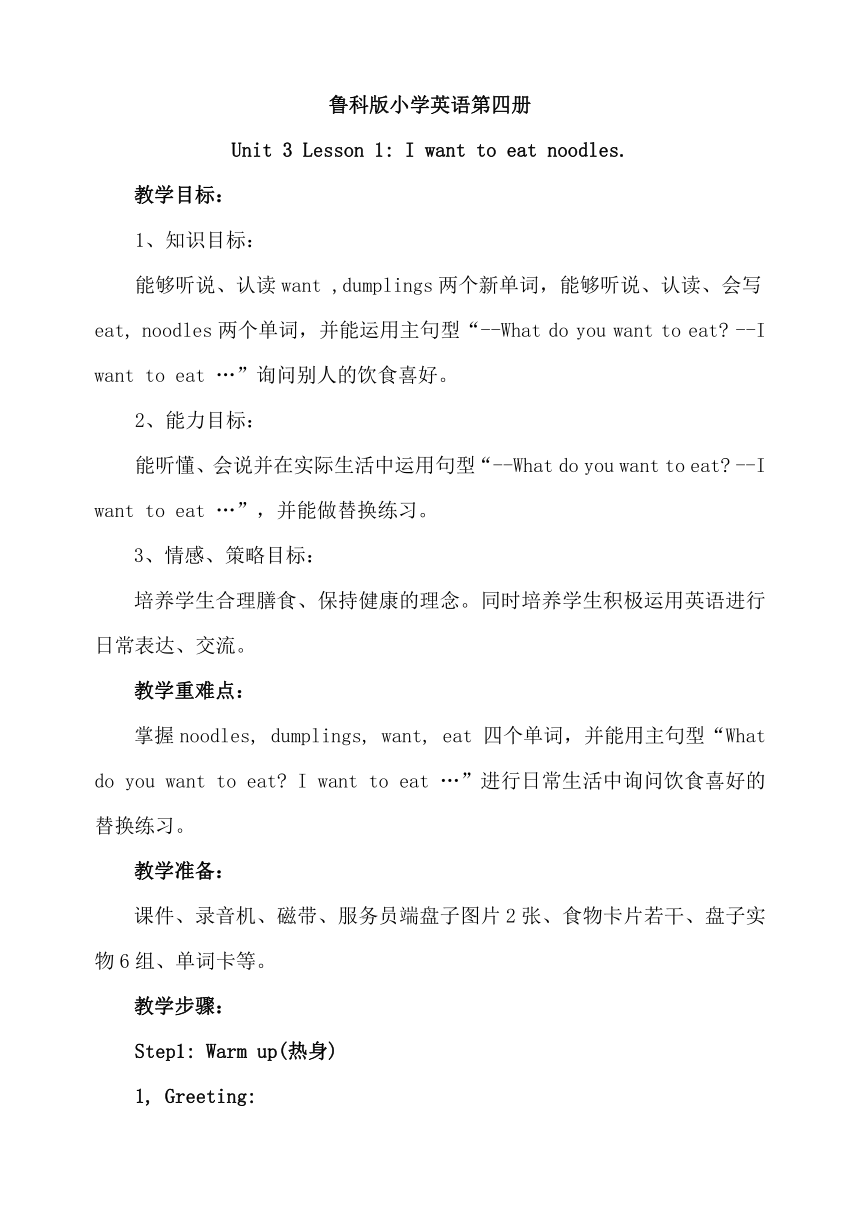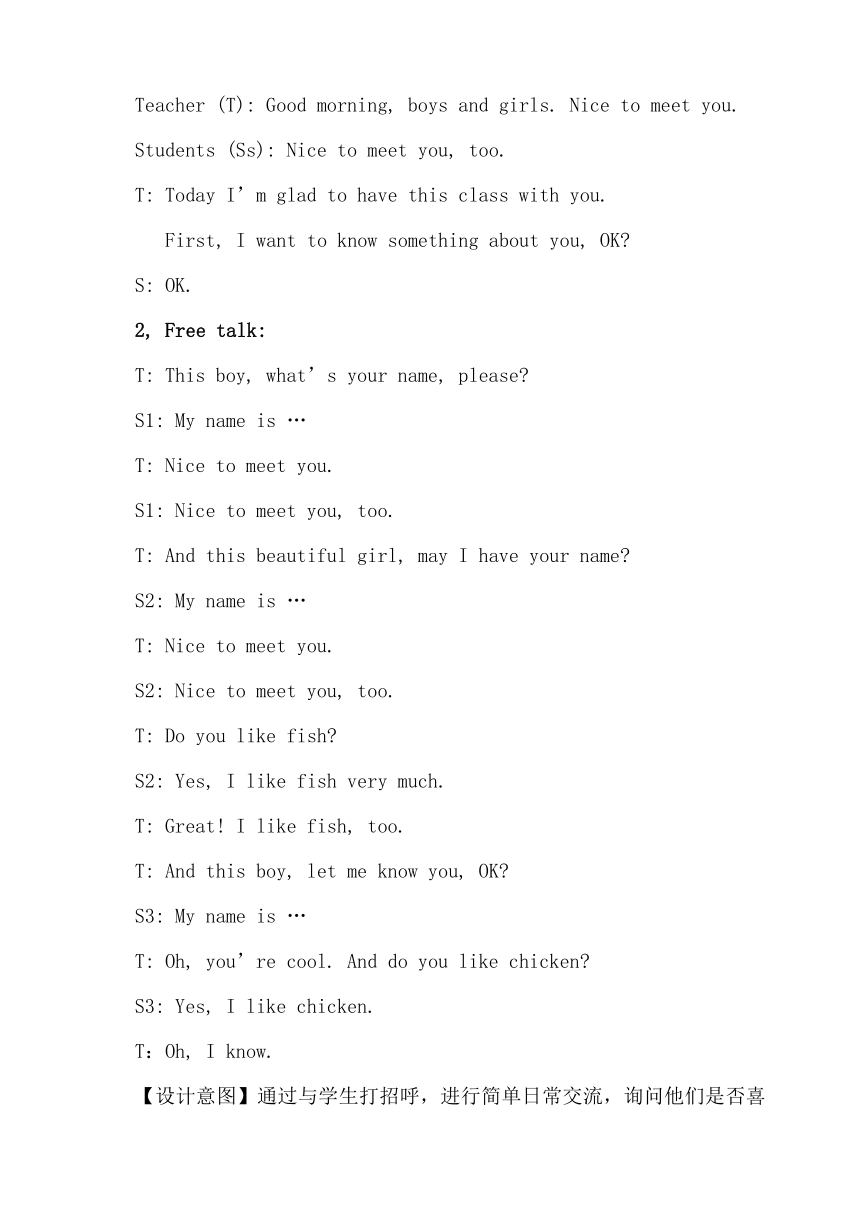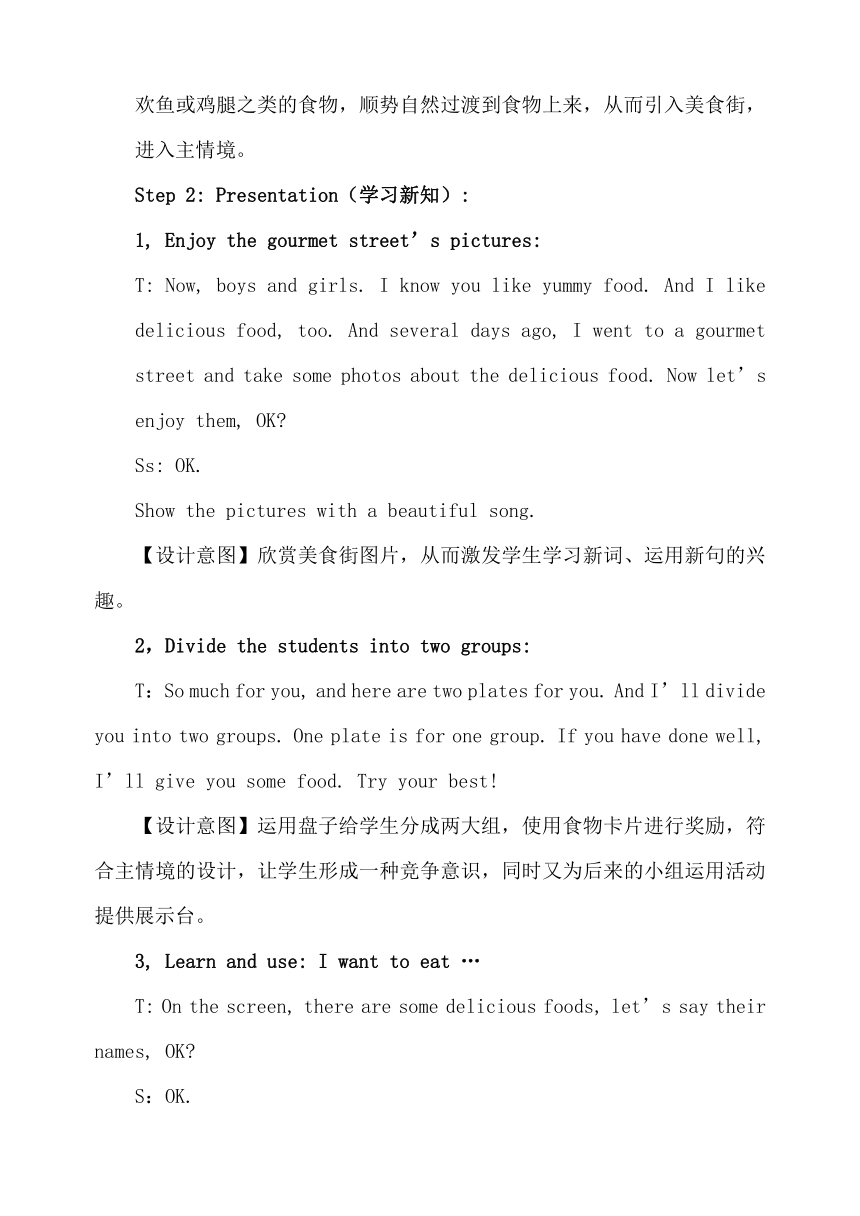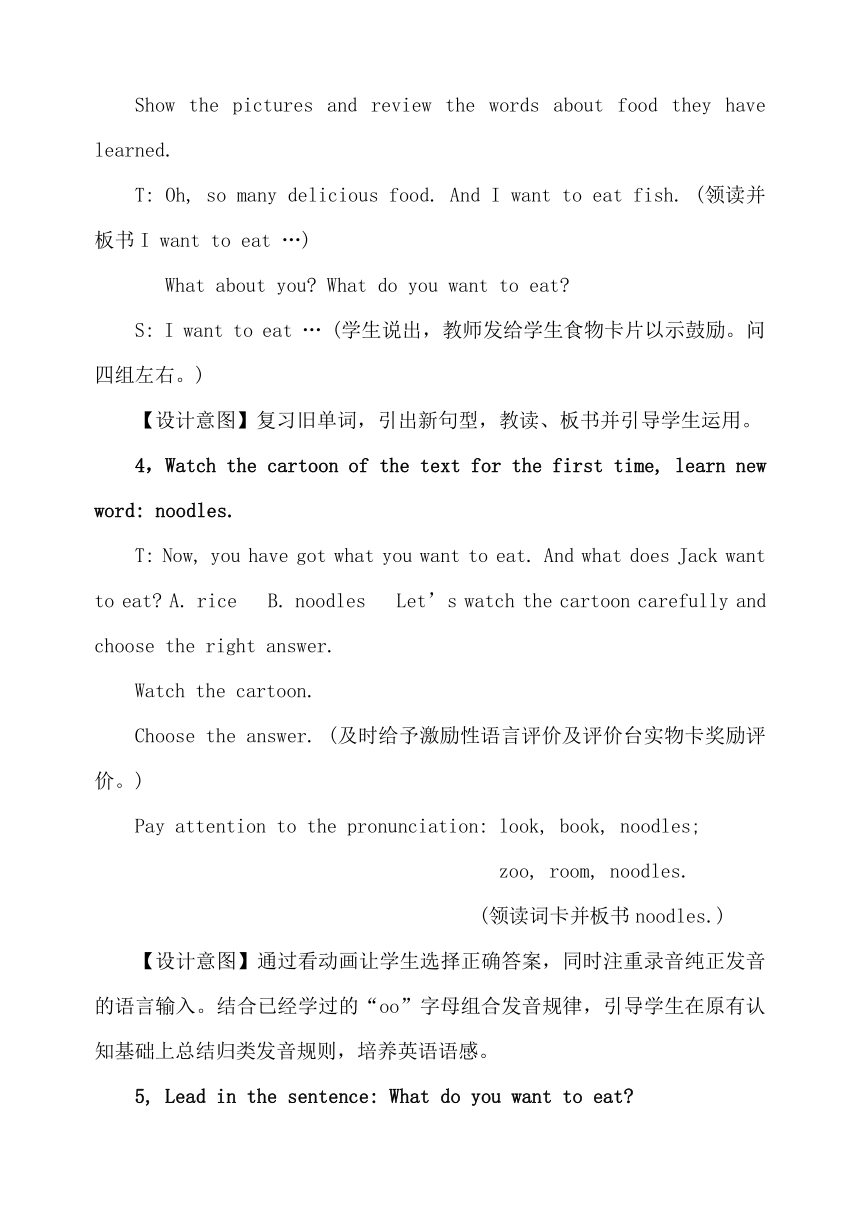英语四年级下鲁科版 Unit 3 RestaurantLesson 1 I want to eat noodles.教案
文档属性
| 名称 | 英语四年级下鲁科版 Unit 3 RestaurantLesson 1 I want to eat noodles.教案 |  | |
| 格式 | zip | ||
| 文件大小 | 2.0MB | ||
| 资源类型 | 教案 | ||
| 版本资源 | 鲁科版(五四制) | ||
| 科目 | 英语 | ||
| 更新时间 | 2014-11-17 17:07:29 | ||
图片预览




文档简介
鲁科版小学英语第四册
Unit 3 Lesson 1: I want to eat noodles.
教学目标:
1、知识目标:
能够听说、认读want ,dumplings两个新单词,能够听说、认读、会写eat, noodles两个单词,并能运用主句型“--What do you want to eat? --I want to eat …”询问别人的饮食喜好。
2、能力目标:
能听懂、会说并在实际生活中运用句型“--What do you want to eat? --I want to eat …”,并能做替换练习。
3、情感、策略目标:
培养学生合理膳食、保持健康的理念。同时培养学生积极运用英语进行日常表达、交流。
教学重难点:
掌握noodles, dumplings, want, eat 四个单词,并能用主句型“What do you want to eat? I want to eat …”进行日常生活中询问饮食喜好的替换练习。
教学准备:
课件、录音机、磁带、服务员端盘子图片2张、食物卡片若干、盘子实物6组、单词卡等。
教学步骤:
Step1: Warm up(热身)
1, Greeting:
Teacher (T): Good morning, boys and girls. Nice to meet you.
Students (Ss): Nice to meet you, too.
T: Today I’m glad to have this class with you.
First, I want to know something about you, OK?
S: OK.
2, Free talk:
T: This boy, what’s your name, please?
S1: My name is …
T: Nice to meet you.
S1: Nice to meet you, too.
T: And this beautiful girl, may I have your name?
S2: My name is …
T: Nice to meet you.
S2: Nice to meet you, too.
T: Do you like fish?
S2: Yes, I like fish very much.
T: Great! I like fish, too.
T: And this boy, let me know you, OK?
S3: My name is …
T: Oh, you’re cool. And do you like chicken?
S3: Yes, I like chicken.
T:Oh, I know.
【设计意图】通过与学生打招呼,进行简单日常交流,询问他们是否喜欢鱼或鸡腿之类的食物,顺势自然过渡到食物上来,从而引入美食街,进入主情境。
Step 2: Presentation(学习新知):
1, Enjoy the gourmet street’s pictures:
T: Now, boys and girls. I know you like yummy food. And I like delicious food, too. And several days ago, I went to a gourmet street and take some photos about the delicious food. Now let’s enjoy them, OK?
Ss: OK.
Show the pictures with a beautiful song.
【设计意图】欣赏美食街图片,从而激发学生学习新词、运用新句的兴趣。
2,Divide the students into two groups:
T:So much for you, and here are two plates for you. And I’ll divide you into two groups. One plate is for one group. If you have done well, I’ll give you some food. Try your best!
【设计意图】运用盘子给学生分成两大组,使用食物卡片进行奖励,符合主情境的设计,让学生形成一种竞争意识,同时又为后来的小组运用活动提供展示台。
3, Learn and use: I want to eat …
T: On the screen, there are some delicious foods, let’s say their names, OK?
S:OK.
Show the pictures and review the words about food they have learned.
T: Oh, so many delicious food. And I want to eat fish. (领读并板书I want to eat …)
What about you? What do you want to eat?
S: I want to eat … (学生说出,教师发给学生食物卡片以示鼓励。问四组左右。)
【设计意图】复习旧单词,引出新句型,教读、板书并引导学生运用。
4,Watch the cartoon of the text for the first time, learn new word: noodles.
T: Now, you have got what you want to eat. And what does Jack want to eat? A. rice B. noodles Let’s watch the cartoon carefully and choose the right answer.
Watch the cartoon.
Choose the answer. (及时给予激励性语言评价及评价台实物卡奖励评价。)
Pay attention to the pronunciation: look, book, noodles;
zoo, room, noodles.
(领读词卡并板书noodles.)
【设计意图】通过看动画让学生选择正确答案,同时注重录音纯正发音的语言输入。结合已经学过的“oo”字母组合发音规律,引导学生在原有认知基础上总结归类发音规则,培养英语语感。
5, Lead in the sentence: What do you want to eat?
T: You know, Jack wants to eat noodles. And how do you know the answer. From picture 1, picture 2, or picture 3?
Ss answer. (激励性语言评价及评价台奖励食物卡片。)
Show the sentence: What do you want to eat? (跟录音读、领读并板书。)
【设计意图】引导学生阅读文本,从而导入问句,进行语言输入与学习。
6,Ask and answer in pairs.
Use the drills: What do you want to eat?
I want to eat …
Show. (展示三组左右,给予激励性语言评价及评价太食物卡片评价。)
【设计意图】学习主句型后,接着进行同桌的机械操练,强化对新学句型的操练。
7,A game : Lucky customer
T: OK, boys and girls, you have done well. And now I’ll give you a surprise. Here’s a game for you : Try to be a lucky customer. And rules for you, please read it by yourself.
Teacher shows and draws.
Ss ask, answer and draw. (进行三组左右的游戏,给予个人语言奖励、实物卡奖励,并给予评价台实物卡奖励。)
【设计意图】设计此游戏是为了在增加趣味性的基础上进一步运用主句型。
8,Watch the cartoon again and learn new word: dumplings.
上一环节的游戏,最后一组抽奖时,放入John 的头像,让学生抽出来后,教师说:Oh, who’s that? That’s John. And what does John want to eat?
Let’s watch the cartoon again and choose the right answer.
Watch the cartoon.
Check the answer.(给予语言评价及评价台上实物卡奖励。)
Learn the new word: dumplings.(领读词卡)
屏幕上出示水饺图片并引导说:These are dumplings.接着出示不同馅的水饺,并引导学生说:fish dumplings, chicken dumplings, vegetable dumplings.然后出示句子:I want to eat … 让学生选择自己喜欢吃的水饺进行表达,同时教师也可以附和:I like fish dumplings, too.或者:You want to eat vegetable dumplings. That’s good for your health.(语言鼓励与评价台食物卡奖励。)
【设计意图】由上一项抽奖游戏,抽出人物John。然后问他想吃什么,再次回到文本动画,进行语言输入,学习新词dumplings。接着结合以前学过的fish, chicken, vegetable 进行词汇的融会贯通,由词扩词,由词扩句:I want to eat … dumplings.
9,Listen and say:
Listen to the tape and repeat.
Good to know. (就Chinese food 进行一个知识补充,了解中西食品。)
Read the text by themselves.
Act it out. (展示表演读对话,及时给予激励性语言评价及评价台奖励。)
【设计意图】打开课本,跟读录音,强化纯正发音,同时渗透一点关于中西食品的小知识,并重点教读一下非主句型的稍微有点难度的句子:I can’t cook Chinese food,扫除学生读课文的障碍。接下来自由练读,展示表演读,让学生对所学进行展示,检查知识掌握的同时增强学生学习英语的成就感。
Step 3: Pretend (拓展延伸)
Count the foods they have got in their plates and go to the gourmet street:
结合评价台上两组同学所获得食物的数量进行表扬与鼓励。接着说:Now let’s go to the gourmet street.黑板上贴上gourmet street的横幅,课件展示Go to the gourmet street(走进美食街)。
教师请三位同学扮演顾客,教师扮演服务员运用黑板评价台上盘子内的食物询问顾客:What do you want to eat? 顾客回答:I want to eat … 服务员便从盘子里取出食物送上,说:… for you.接着问下一位顾客。
教师示范完后,让同学们六人小组内运用事先准备好的食物卡片盘子进行表演运用。
请两组同学上台运用黑板评价台上盘子内的实物卡片进行表演运用。(给予激励性语言评价。)
【设计意图】新知识掌握了以后,就应该创设真实的情境进行输出运用了。所以我运用一开始上课就用的食物评价台创设了走进美食街的拓展延伸活动,教师示范后,小组之内全员参与走进美食街,运用所学语言进行交流,力争做到学以致用。
Step 4: Tips
Keep reasonable diet, keep healthy.(合理膳食,保持健康。)
【设计意图】对学生进行情感教育,引导其注意合理膳食,保持健康。
Step 5: Summary
Fruit garden:收获园内出示本节课所学词汇及句型,总结本课所学。
Step 6: Homework
1、听、认读P24 三遍。
2、完成P25 Let’s do部分。
板书设计:
教学反思:
1,教学中我注重原声语言输入,培养学生语感。
导入课后,我接着提出问题:What does Jack want to eat? 让学生观看文本动画,输入原声语言 noodles,进行跟读。新词 dumplings的学习,我也是同样注重了语言的原声输入,轻松有效地进行了正确的语音教学。
2,整堂课以任务为驱动,激发学生学习、运用语言的积极性与目标指向性。
上课一开始,我与学生进行简单交流后,就结合已学食物为学生创设了美食街的主情境,从而为最后的任务实现做好了铺垫,整堂课我都围绕美食街这个主情境创设输出语言的活动,层层深入,最后让学生做到了学以致用。今后的教学中,我还要更加深入研究创设任务情境,让学生学有所用。
3,个别环节对所有学生的关注度还有所欠缺。
在Lucky customer 环节,我注重了活动的激趣性,学生积极性比较高,但是参与面还是有些不足,需要改进。
Unit 3 Lesson 1: I want to eat noodles.
教学目标:
1、知识目标:
能够听说、认读want ,dumplings两个新单词,能够听说、认读、会写eat, noodles两个单词,并能运用主句型“--What do you want to eat? --I want to eat …”询问别人的饮食喜好。
2、能力目标:
能听懂、会说并在实际生活中运用句型“--What do you want to eat? --I want to eat …”,并能做替换练习。
3、情感、策略目标:
培养学生合理膳食、保持健康的理念。同时培养学生积极运用英语进行日常表达、交流。
教学重难点:
掌握noodles, dumplings, want, eat 四个单词,并能用主句型“What do you want to eat? I want to eat …”进行日常生活中询问饮食喜好的替换练习。
教学准备:
课件、录音机、磁带、服务员端盘子图片2张、食物卡片若干、盘子实物6组、单词卡等。
教学步骤:
Step1: Warm up(热身)
1, Greeting:
Teacher (T): Good morning, boys and girls. Nice to meet you.
Students (Ss): Nice to meet you, too.
T: Today I’m glad to have this class with you.
First, I want to know something about you, OK?
S: OK.
2, Free talk:
T: This boy, what’s your name, please?
S1: My name is …
T: Nice to meet you.
S1: Nice to meet you, too.
T: And this beautiful girl, may I have your name?
S2: My name is …
T: Nice to meet you.
S2: Nice to meet you, too.
T: Do you like fish?
S2: Yes, I like fish very much.
T: Great! I like fish, too.
T: And this boy, let me know you, OK?
S3: My name is …
T: Oh, you’re cool. And do you like chicken?
S3: Yes, I like chicken.
T:Oh, I know.
【设计意图】通过与学生打招呼,进行简单日常交流,询问他们是否喜欢鱼或鸡腿之类的食物,顺势自然过渡到食物上来,从而引入美食街,进入主情境。
Step 2: Presentation(学习新知):
1, Enjoy the gourmet street’s pictures:
T: Now, boys and girls. I know you like yummy food. And I like delicious food, too. And several days ago, I went to a gourmet street and take some photos about the delicious food. Now let’s enjoy them, OK?
Ss: OK.
Show the pictures with a beautiful song.
【设计意图】欣赏美食街图片,从而激发学生学习新词、运用新句的兴趣。
2,Divide the students into two groups:
T:So much for you, and here are two plates for you. And I’ll divide you into two groups. One plate is for one group. If you have done well, I’ll give you some food. Try your best!
【设计意图】运用盘子给学生分成两大组,使用食物卡片进行奖励,符合主情境的设计,让学生形成一种竞争意识,同时又为后来的小组运用活动提供展示台。
3, Learn and use: I want to eat …
T: On the screen, there are some delicious foods, let’s say their names, OK?
S:OK.
Show the pictures and review the words about food they have learned.
T: Oh, so many delicious food. And I want to eat fish. (领读并板书I want to eat …)
What about you? What do you want to eat?
S: I want to eat … (学生说出,教师发给学生食物卡片以示鼓励。问四组左右。)
【设计意图】复习旧单词,引出新句型,教读、板书并引导学生运用。
4,Watch the cartoon of the text for the first time, learn new word: noodles.
T: Now, you have got what you want to eat. And what does Jack want to eat? A. rice B. noodles Let’s watch the cartoon carefully and choose the right answer.
Watch the cartoon.
Choose the answer. (及时给予激励性语言评价及评价台实物卡奖励评价。)
Pay attention to the pronunciation: look, book, noodles;
zoo, room, noodles.
(领读词卡并板书noodles.)
【设计意图】通过看动画让学生选择正确答案,同时注重录音纯正发音的语言输入。结合已经学过的“oo”字母组合发音规律,引导学生在原有认知基础上总结归类发音规则,培养英语语感。
5, Lead in the sentence: What do you want to eat?
T: You know, Jack wants to eat noodles. And how do you know the answer. From picture 1, picture 2, or picture 3?
Ss answer. (激励性语言评价及评价台奖励食物卡片。)
Show the sentence: What do you want to eat? (跟录音读、领读并板书。)
【设计意图】引导学生阅读文本,从而导入问句,进行语言输入与学习。
6,Ask and answer in pairs.
Use the drills: What do you want to eat?
I want to eat …
Show. (展示三组左右,给予激励性语言评价及评价太食物卡片评价。)
【设计意图】学习主句型后,接着进行同桌的机械操练,强化对新学句型的操练。
7,A game : Lucky customer
T: OK, boys and girls, you have done well. And now I’ll give you a surprise. Here’s a game for you : Try to be a lucky customer. And rules for you, please read it by yourself.
Teacher shows and draws.
Ss ask, answer and draw. (进行三组左右的游戏,给予个人语言奖励、实物卡奖励,并给予评价台实物卡奖励。)
【设计意图】设计此游戏是为了在增加趣味性的基础上进一步运用主句型。
8,Watch the cartoon again and learn new word: dumplings.
上一环节的游戏,最后一组抽奖时,放入John 的头像,让学生抽出来后,教师说:Oh, who’s that? That’s John. And what does John want to eat?
Let’s watch the cartoon again and choose the right answer.
Watch the cartoon.
Check the answer.(给予语言评价及评价台上实物卡奖励。)
Learn the new word: dumplings.(领读词卡)
屏幕上出示水饺图片并引导说:These are dumplings.接着出示不同馅的水饺,并引导学生说:fish dumplings, chicken dumplings, vegetable dumplings.然后出示句子:I want to eat … 让学生选择自己喜欢吃的水饺进行表达,同时教师也可以附和:I like fish dumplings, too.或者:You want to eat vegetable dumplings. That’s good for your health.(语言鼓励与评价台食物卡奖励。)
【设计意图】由上一项抽奖游戏,抽出人物John。然后问他想吃什么,再次回到文本动画,进行语言输入,学习新词dumplings。接着结合以前学过的fish, chicken, vegetable 进行词汇的融会贯通,由词扩词,由词扩句:I want to eat … dumplings.
9,Listen and say:
Listen to the tape and repeat.
Good to know. (就Chinese food 进行一个知识补充,了解中西食品。)
Read the text by themselves.
Act it out. (展示表演读对话,及时给予激励性语言评价及评价台奖励。)
【设计意图】打开课本,跟读录音,强化纯正发音,同时渗透一点关于中西食品的小知识,并重点教读一下非主句型的稍微有点难度的句子:I can’t cook Chinese food,扫除学生读课文的障碍。接下来自由练读,展示表演读,让学生对所学进行展示,检查知识掌握的同时增强学生学习英语的成就感。
Step 3: Pretend (拓展延伸)
Count the foods they have got in their plates and go to the gourmet street:
结合评价台上两组同学所获得食物的数量进行表扬与鼓励。接着说:Now let’s go to the gourmet street.黑板上贴上gourmet street的横幅,课件展示Go to the gourmet street(走进美食街)。
教师请三位同学扮演顾客,教师扮演服务员运用黑板评价台上盘子内的食物询问顾客:What do you want to eat? 顾客回答:I want to eat … 服务员便从盘子里取出食物送上,说:… for you.接着问下一位顾客。
教师示范完后,让同学们六人小组内运用事先准备好的食物卡片盘子进行表演运用。
请两组同学上台运用黑板评价台上盘子内的实物卡片进行表演运用。(给予激励性语言评价。)
【设计意图】新知识掌握了以后,就应该创设真实的情境进行输出运用了。所以我运用一开始上课就用的食物评价台创设了走进美食街的拓展延伸活动,教师示范后,小组之内全员参与走进美食街,运用所学语言进行交流,力争做到学以致用。
Step 4: Tips
Keep reasonable diet, keep healthy.(合理膳食,保持健康。)
【设计意图】对学生进行情感教育,引导其注意合理膳食,保持健康。
Step 5: Summary
Fruit garden:收获园内出示本节课所学词汇及句型,总结本课所学。
Step 6: Homework
1、听、认读P24 三遍。
2、完成P25 Let’s do部分。
板书设计:
教学反思:
1,教学中我注重原声语言输入,培养学生语感。
导入课后,我接着提出问题:What does Jack want to eat? 让学生观看文本动画,输入原声语言 noodles,进行跟读。新词 dumplings的学习,我也是同样注重了语言的原声输入,轻松有效地进行了正确的语音教学。
2,整堂课以任务为驱动,激发学生学习、运用语言的积极性与目标指向性。
上课一开始,我与学生进行简单交流后,就结合已学食物为学生创设了美食街的主情境,从而为最后的任务实现做好了铺垫,整堂课我都围绕美食街这个主情境创设输出语言的活动,层层深入,最后让学生做到了学以致用。今后的教学中,我还要更加深入研究创设任务情境,让学生学有所用。
3,个别环节对所有学生的关注度还有所欠缺。
在Lucky customer 环节,我注重了活动的激趣性,学生积极性比较高,但是参与面还是有些不足,需要改进。
同课章节目录
- Unit 1 Countries
- Lesson 1 I'm from Britain.
- Lesson 2 Where's she from?
- Lesson 3 I live in Beijing.
- Lesson 4 Again, please!
- Unit 2 Housework
- Lesson 1 Can you clean the windows?
- Lesson 2 What are you doing?
- Lesson 3 What's mum doing?
- Lesson 4 Again, please!
- Unit 3 Restaurant
- Lesson 1 I want to eat noodles.
- Lesson 2 What would you like?
- Lesson 3 Would you like something to drink?
- Lesson 4 Again, please!
- Unit 4 Weekend
- Lesson 1 Sometimes I do housework.
- Lesson 2 He often plays football.
- Lesson 3 Does he often play the violin?
- Lesson 4 Again, please!
- Unit 5 Shopping
- Lesson 1 Can I help you?
- Lesson 2 Do you have schoolbags?
- Lesson 3 How much is this shirt?
- Lesson 4 Again, please!
- Unit 6 Travel
- Lesson 1 I'm going to Mount Taishan.
- Lesson 2 How are you going there?
- Lesson 3 What are you going to do there?
- Lesson 4 Again, please!
